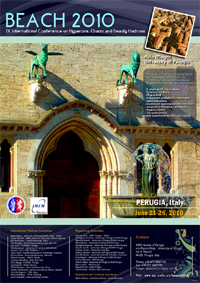Speaker
Description
Summary
Due to their large masses, heavy flavor ($c$ and $b$) quarks are produced in the early stages of heavy ion
collisions where the full initial energy is available for particle production.
Radiative energy loss in dense partonic matter is thought to be inversely proportional
to the quark mass. Early measurements of heavy flavor energy loss at RHIC using the
decay-electron spectra of D and B mesons showed a suppression similar to that of light quarks.
This puzzling result lead theorists to re-speculate the cause of this effect. Experimentally
it is difficult to separate the charm and bottom contributions in the electron spectra.
The two major experiments at RHIC, PHENIX and STAR both decided to upgrade their silicon vertex
detectors in order to be able to improve their measuring capabilities.
The STAR approach and goal is to obtain
a precise measurement of heavy flavor production by identifying the decay
of charmed mesons using direct topological reconstruction and thus disentangling the $c$
and $b$ contributions.
In this talk we will present a brief report on the current status of measurements and future prospects.

